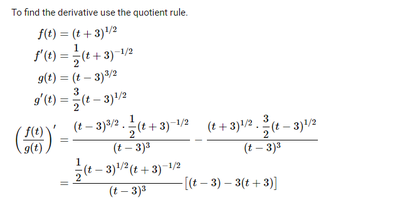I wasn't sure where to post this because it's sort of an algebraic problem I'm having . Here is the prompt

So I found that I'm struggled in these questions because I wasn't simplifying correctly.

I have no idea how the fifth line simplifies to the last line. Specificially I don't know how it gets to [(t-3)-3(t+3)]. If you have any resources you can share I would love to fill this gap in my knowledge.

So I found that I'm struggled in these questions because I wasn't simplifying correctly.

I have no idea how the fifth line simplifies to the last line. Specificially I don't know how it gets to [(t-3)-3(t+3)]. If you have any resources you can share I would love to fill this gap in my knowledge.
